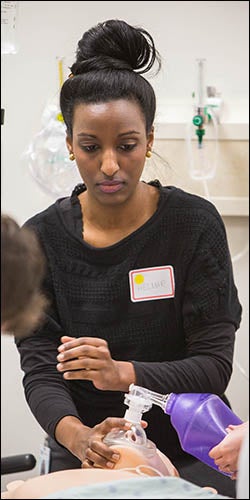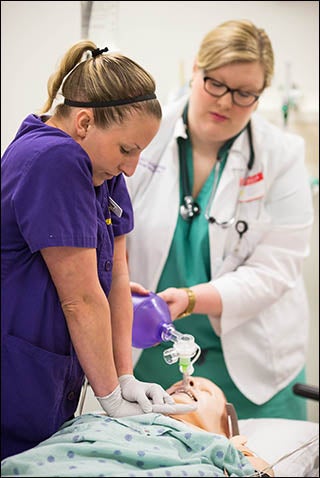COLLABORATIVE CARE
Training brings future doctors, nurses together in clinical simulations
Three nurses and two physicians started their assessment when Jones, who had been coughing non-stop, said he couldn’t breathe. “Let’s get him some oxygen,” a doctor said. “We may have to intubate.”
His care team was actually fourth-year East Carolina University nursing and medical students, and Jones was a mannequin in the Brody School of Medicine’s Clinical Simulation Center. Close to 200 students, about to graduate to nursing careers and residency, trained together in a “transition collaborative” held March 17-19.

Fourth-year medical student Helmae Wubneh said the simulation exercise was the first time she had worked as a team with her fellow students in nursing.
“They’ve come in contact together in clinical settings, but we’ve never had them work together in teams before as part of the curriculum,” said Dr. Luan Lawson, assistant dean of curriculum, assessment and clinical academic affairs in the Brody School of Medicine.
While the exercise tested the students’ knowledge and readiness, it also measured communication skills. Students weren’t technically graded but did get feedback from experienced physicians, nurses and faculty members who observed the 10-minute clinical scenarios.
“Medicine is very team-oriented,” Lawson said. “We can deliver high quality and safer care to our patients by focusing on teamwork.”
Medical errors or adverse events are often caused by poor communication by health care providers, Lawson said.
“We spend so much time on communication skills with our patients, but we rarely spend time on our own communication skills,” she said. “This is an opportunity for us to change this important aspect.”
While in settings with real patients, students usually aren’t the lead provider on cases that involve opening a crash cart – a rolling cabinet with supplies and equipment needed in an emergency – or caring for someone in respiratory arrest. Simulation gives students the experience in a safety zone and helps them recognize areas for improvement, Lawson said.
The scenario was designed for the patient “to not do well,” Lawson said. “The patient was in respiratory distress. He can’t breathe. His oxygen levels won’t stay up.”
The students intubated (inserted a breathing tube or artificial airway into the windpipe), and gave Jones medicine to control his blood pressure, but nothing helped.
“You’re doing everything right, and the patient continues to worsen. We feel it’s better to experience it here in a simulated environment rather than a live one,” Lawson said.
“I started thinking about ‘what else can we do?’ ” said Helmae Wubneh of Greenville, a fourth-year medical student headed to George Washington University for a residency in pathology.
While she has performed simulation training in various rotations, it was the first time she worked with nursing students. “It makes it a bit more reflective of the environment we’ll actually work in,” said Wubneh. “It’s a good idea. It helps you know when you need to improve and how you work in a group.”
At the end of the exercise, students gathered with the ECU faculty observers to talk about the case, which included Jones’ “wife” entering the room during treatment. Having someone talk with the family member to provide more information is important.

Nursing student C. Robinson applies pressure to the simulated patient, while medical student Laura Pekman assists with respiration.
“Be careful of communicating in slang terms,” said Dr. Gina Woody, clinical associate professor in the College of Nursing.
“When they (family members) hear these things, they become more anxious. Give patients and family members small amounts of information they can understand.”
Skylar Rose, a 22-year-old nursing student from Hendersonville, said the exercise reinforced the importance of teamwork and communication, including communicating better with family members.
“We’ve had simulation training in nursing, but it was definitely different with the medical students. The monitors were different (than in the College of Nursing),” Rose said. “I did what was needed and what I was trained to do.”
Lori Levy, a doctoral nursing student and observer, told students once they begin work that it’s important to look around the floor or clinic where they will be stationed to become familiar with resources and where equipment is kept.
Offering more simulation training, specifically for fourth-year students, would be beneficial, said John Lazzari, a 22-year-old nursing student from Wilmington. “Everyone was a little unsure of themselves and what their role was,” he said. “If we had the opportunity to do it again, we’d do better.
“I went in with the expectation the patient was going to need some serious help, and he did,” Lazzari said.
Feedback from faculty is helpful, he said. “It’s important to know what you have to work on,” Lazzari said. “It’s not always skills. It could be communication, or not necessarily jumping to medication as a treatment, but talking with the patient to figure out what is going on with them.”
Organizers are planning more collaborative opportunities, but the current curriculum presents challenges with undergraduate nursing students following a traditional academic calendar and medical graduate students enrolled year-round.
Nursing already has all of its 500 undergraduate nursing students train in teams over four days in the college’s simulation labs. Administrators hope to add medical students this fall, said Dr. Annette Peery, chair of the College of Nursing’s undergraduate nursing science, senior division.
“We hope it will help them to facilitate teamwork and better communicate in the clinical setting. We know those two things will improve patient outcomes. It has been a huge push across the country,” Peery said.
More than 25 ECU faculty members from medicine and nursing were involved in the transition collaborative, an inaugural interprofessional activity of ECU’s REACH, or Redesigning Education to Accelerate Change in Healthcare. The Brody School of Medicine is one of 11 medical schools nationwide that received grants through the American Medical Association’s Accelerating Change in Medical Education Initiative, which aims to change the way medical education is taught.
The faculty included members of the Teachers of Quality Academy, who designed and implemented high-fidelity simulation and TeamSTEPPS training for the students, Lawson said. TeamSTEPPS is an evidence-based, teamwork system designed for health care professionals.
